"Don't go chasing waterfallsPlease stick to the rivers and the lakes that you're used toI know that you're gonna have it your way or nothing at allBut I think you're moving too fast"
Waterfalls (1994) by TLC
Continuing from the account of my adventure at the Kubah National Park two days ago, I descended Mount Serapi and seeing as time was a commodity I had in excess supply, I decided to take a detour to an unnamed waterfall out in the rainforest. I have been there once before nine years ago with a bunch of my Taylor's College mates and had a great time, so I was partially motivated by nostalgia as well.
My walk down the concrete path was accompanied by a harsh, deafening, cyclical, buzzing crescendo that suffuses the canopy followed by a brief wheeze of exhaustion before starting up again like clockwork. I know that Kubah is home to the world largest species of cicada (the empress cicada or Pomponia imperatoria) but what I heard was quite different from that cicada's unmistakable shimmery evening drone. For one thing, the machine-like cacophony I heard peaked in the afternoon. Anyway, I crowdsourced this on the Malaysian Atheists, Freethinkers and Agnostic Facebook group and one of the members there correctly identified it as the tymbalisation of the jade-green cicada (Dundubia vaginata).
I stuck my camera atop of my fully extended tripod and raised it as high as I could to record this.
Anyway, the route to the waterfall sprouts off the gentle Serapi Summit Walk a third of the way from the park headquarters and it was clearly marked by a signboard that is adorned with pictures of flora and fauna one can expect to see along the trail. I find that a great touch and nature enthusiasts such as myself can use it to guide our amateur observations.
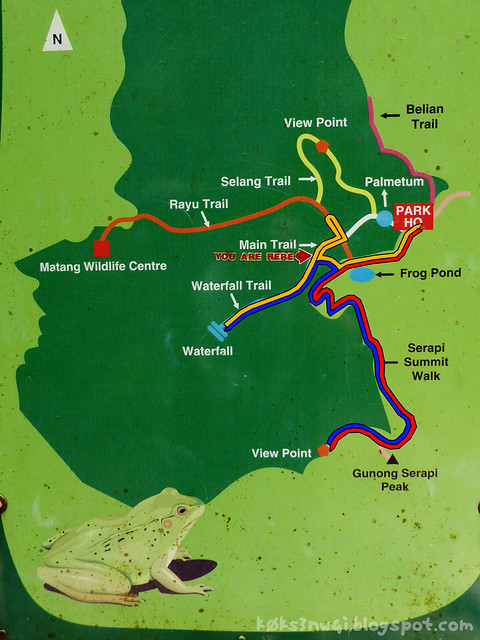 |
| Red: My walk from park headquarters to the summit of Mount Serapi. Blue: My hike to the waterfall from the top of Serapi. Yellow: My journey back to park headquarters. |
Within the first minute, I spotted one of the stars of the trail: stingless bees. Stingless bees form the tribe Meliponini and there are approximately 500 species within it. Meliponines actually do have stingers but they are reduced and vestigial, and cannot be used for defence. The ones I found were nesting at the base of a large tree in waxy, chimney-pot hives.
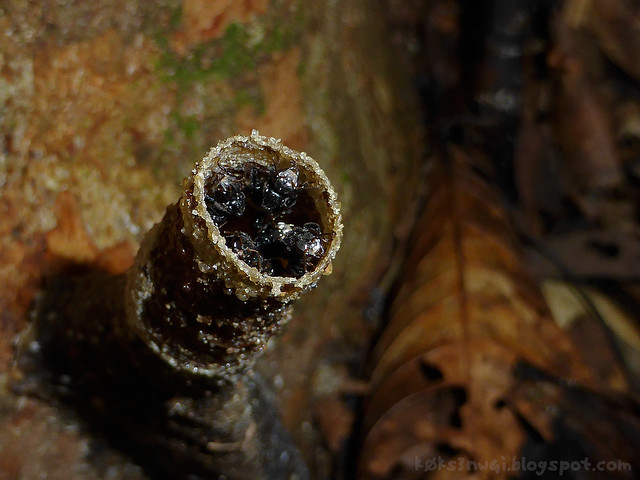 |
| If I wasn't pre-informed, I would have thought that these black buzzing insects are flies. |
In the same location, I also managed to photograph this alarmingly large ant.
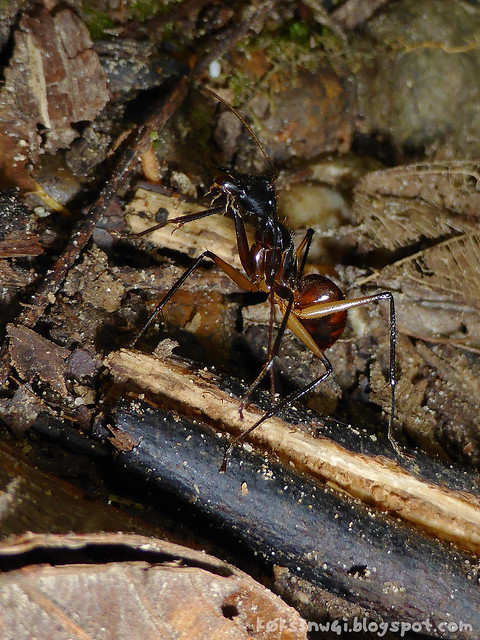 |
| It seems to be carrying some detritus in its mandibles. |
The giant forest ant (Camponotus gigas) I saw was almost 2 centimetres in length and judging the size of its head and mandibles, it was probably a worker. These ants typically forage at night but a small handful would venture out in the daytime as well, and research into the ants activity have shown that those who are marked as "night duty" ants would only go out at night and those marked for "day duty" only go out in the day, with no overlap. So yeah, there are way more of these massive ants from hell scuttling across the leaf litter after dark, so if you are into night safaris, I bid you good luck.
The trail to the waterfall will probably not twist any ankles or break any backs, but compared to the trail to the top of Serapi, it was a tad more challenging. Segments of boardwalk interrupt the path on the forest floor at the roughest bits and any obstacles lying across the trail, usually fallen trees, are integrated into the trail itself.
 |
| Integration. |
The trail is friendly and short enough (1.5 kilometre, taking about an hour one way) for young children, as a family I ran into can attest. They were heading back from the waterfall and tagging along were two primary school kids who were having the gayest old time. The patriarch of the family was carrying some heavy looking photography gear and told me that he managed to take some pictures of frogs, for which Kubah is known.
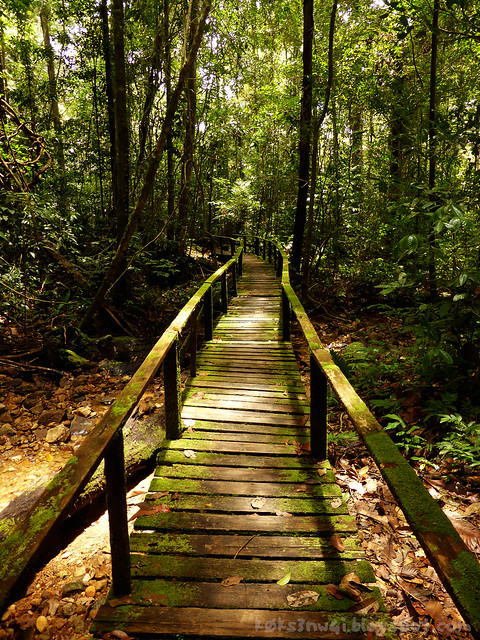 |
| Moss-covered boardwalk. |
As I got closer to the waterfall, I started seeing more streams and ponds along the trail and there appeared to be no shortage of freshwater fishes in them. One of the more interesting specimen I saw was this 6-inch long Channidae or snakehead which was terrorising smaller fishes in its little duchy.
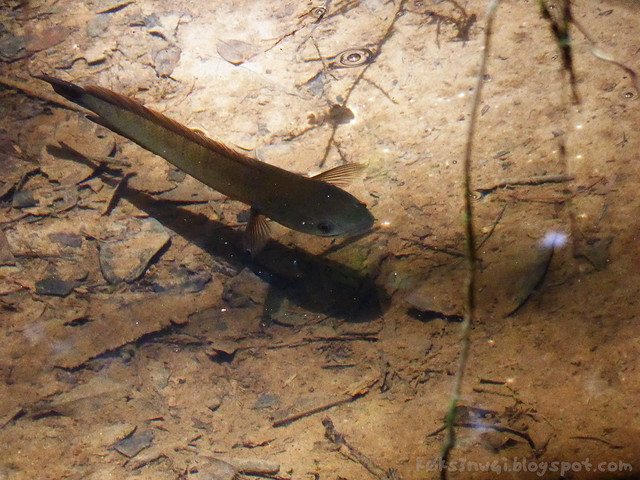 |
| The biggest fish in the pond. |
It was quite relaxing to watch it drift lazily towards its prey before striking lightning fast to vanish it, before resuming its languid cruise in and out of the sunlit patches of the pond. I'm starting to see the appeal of keeping an aquarium.
Slowly but surely, the trail veered closer and closer to a large, fast-flowing stream on the right and before long, I could even hear the incessant pounding of water on rocks from the waterfall ringing out from ahead. In my haste to reach my destination, I accidentally disturbed a smooth, slender, bright green snake which gave my monkey brain quite a fright when it darted out from under a pile of detritus of the forest floor and promptly disappeared under another pile. Since I didn't manage to get a good look at its head, I was unable to identify the little serpent.
After 40 minutes from the main trail, I arrived at the waterfall.
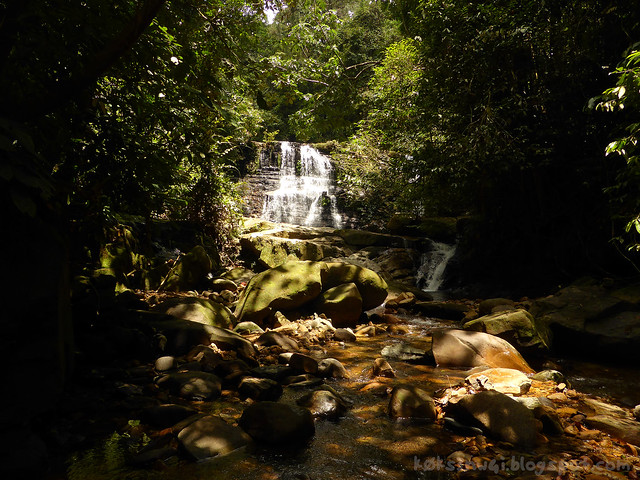 |
| Ain't it a right little Eden? |
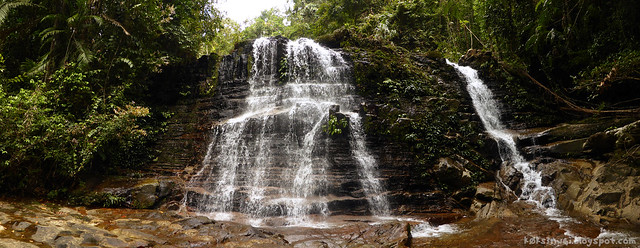 |
| Stitched photograph of the waterfall. Click to enlarge. |
Mount Singai and the Kubah National Park is part of the Plateau Sandstone formation and geologically they are made up of massive cross-bedded sandstone, mudstone and silty shale, and the waterfall itself cascades down a multi-layered shale-shelf that resembles one of Sarawak's famous kek lapis.
A lady in her forties was already there busy taking pictures with her pink point-and-shoot camera along with a young Chinese couple. The older lady soon left, leaving the lovers to sunbathe on a large stone slab. When it was clear that I wasn't going to leave any time soon, the lovebirds also took their leave, presumably to make out behind a tree somewhere.
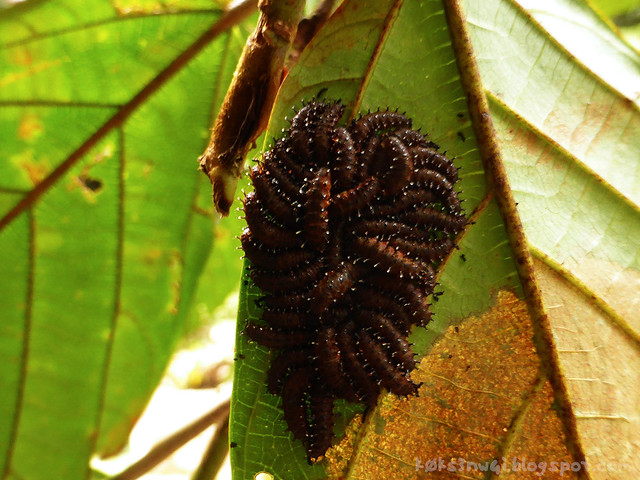 |
| A deeply upsetting cluster of some immobile worm-like horrors under a leaf. |
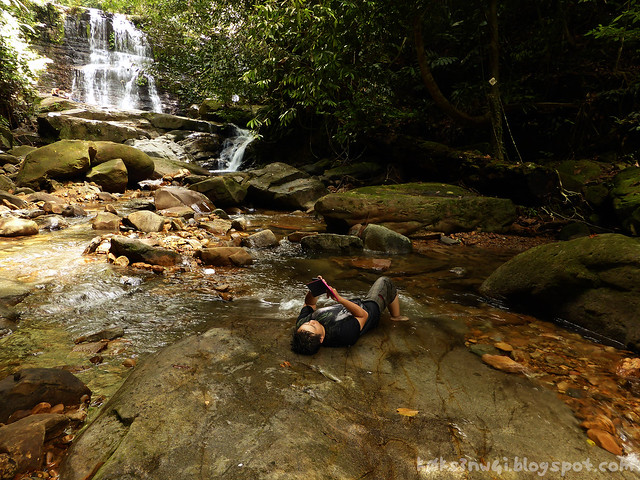 |
| Me, chilling out on a nice, cool rock reading my new Kindle as the water ran around my body. Guess how I took this picture. |
The waterfall area is an amazing spot for picnicking and bathing, and my only complaint was that the water was not deep enough to swim in. After getting bored of soaking in the cold, clear mountain water, I built a small dam to deepen the rock-pool I was splashing in, raising the water level by about a feet. I am quite certain that my dam would be washed away by the next rainstorm.
After putting on a fresh set of clothing, I left the waterfall at about 3:00PM to head out of the park.
 |
| A tank-like polydesmid millipede I spotted on the trek back. |
In about half an hour, I expected to exit Kubah but on a whim, I decided to take an alternate route through the jungle. I somehow accidentally gotten on the Rayu Trail and walked about 800 metres before realising that I needed to turn back. It was five in the evening by the time I got back to my car.
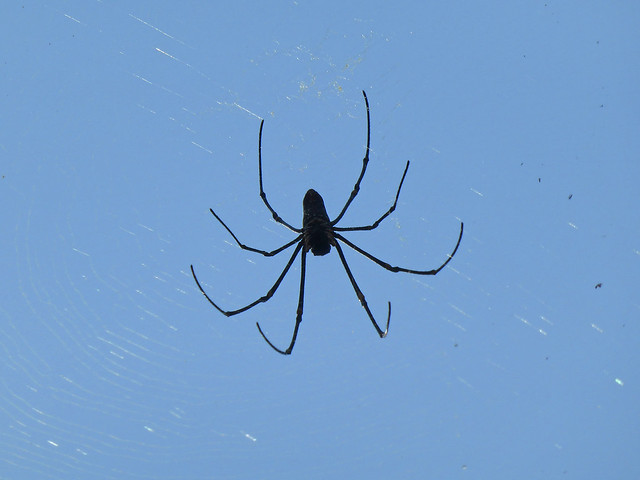 |
| A massive spider about the size of my palm, sitting in a web strung across two palm trees in front of the park headquarters. |
On my way out, I realised that there's a designated Pitcher Plant Conservation Area near the park's entrance and having never seen a pitcher plant up close in my life before, vowed to return one day to remedy that deficiency. There are cabins and hostels for rent there as well so I might just try to do some frog-watching someday during nightfall.
After close to three years on living on the island of Borneo, I am really starting to appreciate just how accessible one of the richest, most bio-diverse ecosystems in the world is to me.
PART ONE: A Walk Up Mount Serapi of Kubah National Park
Bathed in falling water,
k0k s3n w4i

No comments:
Post a Comment